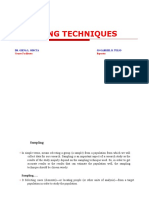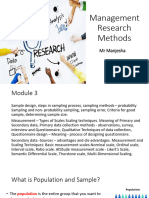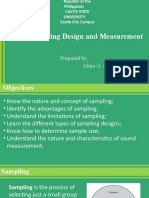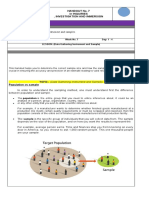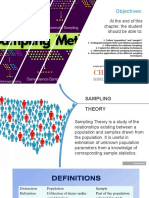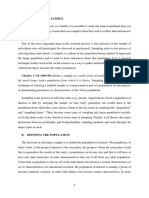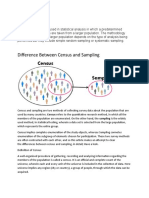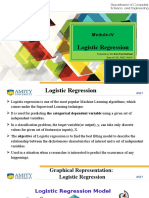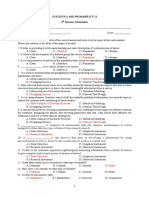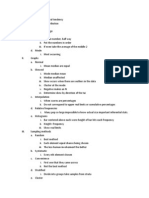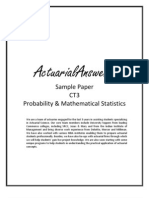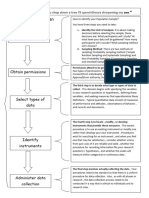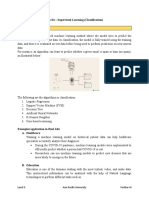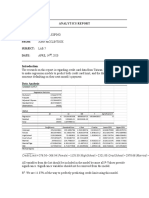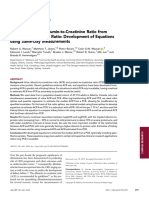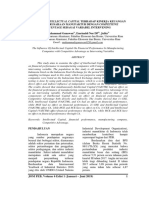Types of Sampling: Sampling Methods with Examples
Population and Sample
1. Population
In research terminology the Population can be explain as a comprehensive group of individuals,
institutions, objects and so forth with have a common characteristics that are the interest of a researcher.
The common characteristics of the groups distinguish them from other individual, institutions, objects
and so forth. The term universe is also used as synonyms to population. Sometimes population can be
counted easily, which is called finite population. Population of medical students is an example of finite
population. The unlimited or unknown number of population can be called as infinite population. The
adolescents, youths in Telungana can be treated as examples for infinite population, though they can
be counted but in complex procedure.
Any value, which is identified or measured from the characteristics of entire population, can be called as
Parameter. The process of conducting a survey to collect data from the entire population is called a
census.
2. Sample
In social science and educational research, practically it is not possible to a researcher to approach all
the individuals\elements in a population for the purpose of data collection. Instead, they select and
approach a representative group of individuals/elements who falls under the particular population to
collect needed information regarding the group. Based on the results, the researcher generalizes the
characteristics of the representative group as the characteristics of population. This 2 small group or
representative group from a population is called as sample. So sample can be defined as the small
portion of a population selected for a particular study. The sample should clearly represent the
characteristics of intended group. According to Young, “A statistical sample is a miniature picture of
cross selection of the entire group or aggregate from which the sample is taken”. The process of
conducting a survey to collect data from a sample is called sample survey. The value, which is identified
or measured from the characteristics of the sample, can be termed as statistic.
3. Sampling
The process of selection or the drawing of the accurate representation of a unit, group or sample from a
population of interest is called as sampling. Sampling can be done through various sampling techniques
in accordance with the nature of the sample as well as the subject matter of the study. It is the Sampling
procedure, which will decide the accurate representation of the sample selected for the study as well as
the relevance of generalization made from the research.
4. Sampling Unit
Each individual or case that constitutes a sample is called a sampling unit or sampling element. For
example if a sample constitutes 200 teachers, each teachers in the sample are considered as a sampling
unit.
5. Sampling Frame
Sampling frame is the list of subjects/people under the study, such as household, students, teachers,
principals and so forth. The list should be comprehensive as well as latest. For example, Telephone
directory, Students database from department of school education, list of school principal from the official
website of concern department and so forth.
1
�6. Sample Size
As name indicates sample size is the total number of sample selected for the study. For example, it is
the number of teachers, students or stakeholders from a researcher intended to collect information
regarding his research questions. There is no notion about the minimum or maximum number of sample;
instead, the sample size should be optimum. Usually the sample size is denoted by the letter (n).
7. Sampling Error
The variation between the means of sample groups as well as population mean is called sampling error.
It can be understood through the following example. A researcher planned to conduct a study on
Emotional Intelligence of secondary school 3 students in Telungana state. Definitely, the researcher has
to selects accurate representation or optimum sample from the large population of his study. Suppose
the researcher has selected ten groups or samples each consisting of 200 students from same
population. He administered his research tool in each sample, collected the data, organized, scored and
found the mean scores of each group. Finally, he can see that each group shows differences in their
mean scores with another group or sample as well as with the population mean. This is because of; a
random sample will not be identical representation of a population. A few would be relatively high, a few
relatively low, but most could tend to cluster around the population means. This variation of sample
means is due to sampling error. The term does not suggest any mistake in the sampling process, but
merely describe the chance variations that are inevitable when a number of randomly selected sample
means are computed. Hence the variation between the sample mean and the population mean are
called sampling error.
8. Representative and Biased sample
Representative samples are the samples, which are closely, match the actual characteristics of the
population from where the samples have been drawn. When a researcher select the sample through
systematic and scientific way and ensure the optimum sample size, he/she can ensure the
representative sample for his/her study. Biased sample can be defined as the sample, which is not
representative of the actual/common characteristic of the population from which it was drawn. A
researcher may select biased sample intentionally or unintentionally. For example when a researcher
intents to establish a favorable outcome over others, he may adopt biased sampling technique to ensure
the indented results. Suppose if a researcher want to prove relationship between the Intelligence and
school discipline, he may select the students as a sample for the study from the class who maintain high
discipline as well as high intelligence, whereas there might have several classes in that particular school
where people are with high IQ but low discipline. In unintentional cases, the same thing might be happen
through the random selection of the particular class from a several classes of the school. Even though
it is an unintentional selection of the sample, it should have affected the result of the study as it was not
the real representation of the actual characteristics of the population.
2
� Types of Sampling: Sampling Methods with Examples
What is sampling?
Sampling is a technique of selecting individual members or a subset of the population to make statistical
inferences from them and estimate characteristics of the whole population. Different sampling methods
are widely used by researchers in market research so that they do not need to research the entire
population to collect actionable insights.
It is also a time-convenient and a cost-effective method and hence forms the basis of any research
design. Sampling techniques can be used in a research survey software for optimum derivation.
For example, if a drug manufacturer would like to research the adverse side effects of a drug on the
country’s population, it is almost impossible to conduct a research study that involves everyone. In this
case, the researcher decides a sample of people from each demographic and then researches them,
giving him/her indicative feedback on the drug’s behavior.
Types of sampling: sampling methods
Sampling in market research is of two types – probability sampling and non-probability sampling. Let’s
take a closer look at these two methods of sampling.
1. Probability sampling: Probability sampling is a sampling technique where a researcher sets a
selection of a few criteria and chooses members of a population randomly. All the members have an
equal opportunity to be a part of the sample with this selection parameter.
2. Non-probability sampling: In non-probability sampling, the researcher chooses members for
research at random. This sampling method is not a fixed or predefined selection process. This makes
it difficult for all elements of a population to have equal opportunities to be included in a sample.
In this blog, we discuss the various probability and non-probability sampling methods that you can
implement in any market research study.
3
� Types of probability sampling with examples:
Probability sampling is a sampling technique in which researchers choose samples from a larger
population using a method based on the theory of probability. This sampling method considers every
member of the population and forms samples based on a fixed process.
For example, in a population of 1000 members, every member will have a 1/1000 chance of being
selected to be a part of a sample. Probability sampling eliminates bias in the population and gives all
members a fair chance to be included in the sample.
There are four types of probability sampling techniques:
Simple random sampling: One of the best probability sampling techniques that helps in saving time
and resources, is the Simple Random Sampling method. It is a reliable method of obtaining
information where every single member of a population is chosen randomly, merely by chance. Each
individual has the same probability of being chosen to be a part of a sample.
For example, in an organization of 500 employees, if the HR team decides on conducting team
building activities, it is highly likely that they would prefer picking chits out of a bowl. In this case,
each of the 500 employees has an equal opportunity of being selected.
Cluster sampling: Cluster sampling is a method where the researchers divide the entire population
into sections or clusters that represent a population. Clusters are identified and included in a sample
4
� based on demographic parameters like age, sex, location, etc. This makes it very simple for a survey
creator to derive effective inference from the feedback. For example, if the United States government
wishes to evaluate the number of immigrants living in the Mainland US, they can divide it into clusters
based on states such as California, Texas, Florida, Massachusetts, Colorado, Hawaii, etc. This way
of conducting a survey will be more effective as the results will be organized into states and provide
insightful immigration data.
Systematic sampling: Researchers use the systematic sampling method to choose the sample
members of a population at regular intervals. It requires the selection of a starting point for the sample
and sample size that can be repeated at regular intervals. This type of sampling method has a
predefined range, and hence this sampling technique is the least time-consuming.
For example, a researcher intends to collect a systematic sample of 500 people in a population of
5000. He/she numbers each element of the population from 1-5000 and will choose every 10th
individual to be a part of the sample (Total population/ Sample Size = 5000/500 = 10).
Stratified random sampling: Stratified random sampling is a method in which the researcher
divides the population into smaller groups that don’t overlap but represent the entire population.
While sampling, these groups can be organized and then draw a sample from each group separately.
For example, a researcher looking to analyze the characteristics of people belonging to different
annual income divisions will create strata (groups) according to the annual family income. Eg – less
than $20,000, $21,000 – $30,000, $31,000 to $40,000, $41,000 to $50,000, etc. By doing this, the
researcher concludes the characteristics of people belonging to different income groups. Marketers
can analyze which income groups to target and which ones to eliminate to create a roadmap that
would bear fruitful results.
Uses of probability sampling
There are multiple uses of probability sampling:
Reduce Sample Bias: Using the probability sampling method, the bias in the sample derived from
a population is negligible to non-existent. The selection of the sample mainly depicts the
understanding and the inference of the researcher. Probability sampling leads to higher quality data
collection as the sample appropriately represents the population.
Diverse Population: When the population is vast and diverse, it is essential to have adequate
representation so that the data is not skewed towards one demographic. For example, if Square
would like to understand the people that could make their point-of-sale devices, a survey conducted
from a sample of people across the US from different industries and socio-economic backgrounds
helps.
Create an Accurate Sample: Probability sampling helps the researchers plan and create an
accurate sample. This helps to obtain well-defined data.
Types of non-probability sampling with examples
The non-probability method is a sampling method that involves a collection of feedback based on a
researcher or statistician’s sample selection capabilities and not on a fixed selection process. In most
situations, the output of a survey conducted with a non-probable sample leads to skewed results, which
may not represent the desired target population. But, there are situations such as the preliminary stages
of research or cost constraints for conducting research, where non-probability sampling will be much
more useful than the other type.
Four types of non-probability sampling explain the purpose of this sampling method in a better manner:
5
� Convenience sampling: This method is dependent on the ease of access to subjects such as
surveying customers at a mall or passers-by on a busy street. It is usually termed as convenience
sampling, because of the researcher’s ease of carrying it out and getting in touch with the subjects.
Researchers have nearly no authority to select the sample elements, and it’s purely done based on
proximity and not representativeness. This non-probability sampling method is used when there are
time and cost limitations in collecting feedback. In situations where there are resource limitations
such as the initial stages of research, convenience sampling is used. For example, startups and
NGOs usually conduct convenience sampling at a mall to distribute leaflets of upcoming events or
promotion of a cause – they do that by standing at the mall entrance and giving out pamphlets
randomly.
Judgmental or purposive sampling: Judgemental or purposive samples are formed by the
discretion of the researcher. Researchers purely consider the purpose of the study, along with the
understanding of the target audience. For instance, when researchers want to understand the
thought process of people interested in studying for their master’s degree. The selection criteria will
be: “Are you interested in doing your masters in …?” and those who respond with a “No” are excluded
from the sample.
Snowball sampling: Snowball sampling is a sampling method that researchers apply when the
subjects are difficult to trace. For example, it will be extremely challenging to survey shelterless
people or illegal immigrants. In such cases, using the snowball theory, researchers can track a few
categories to interview and derive results. Researchers also implement this sampling method in
situations where the topic is highly sensitive and not openly discussed—for example, surveys to
gather information about HIV Aids. Not many victims will readily respond to the questions. Still,
researchers can contact people they might know or volunteers associated with the cause to get in
touch with the victims and collect information.
Quota sampling: In Quota sampling, the selection of members in this sampling technique happens
based on a pre-set standard. In this case, as a sample is formed based on specific attributes, the
created sample will have the same qualities found in the total population. It is a rapid method of
collecting samples.
Uses of non-probability sampling
Non-probability sampling is used for the following:
Create a hypothesis: Researchers use the non-probability sampling method to create an
assumption when limited to no prior information is available. This method helps with the immediate
return of data and builds a base for further research.
Exploratory research: Researchers use this sampling technique widely when conducting qualitative
research, pilot studies, or exploratory research.
Budget and time constraints: The non-probability method when there are budget and time
constraints, and some preliminary data must be collected. Since the survey design is not rigid, it is
easier to pick respondents at random and have them take the survey or questionnaire.
How do you decide on the type of sampling to use?
For any research, it is essential to choose a sampling method accurately to meet the goals of your
study. The effectiveness of your sampling relies on various factors. Here are some steps expert
researchers follow to decide the best sampling method.
Jot down the research goals. Generally, it must be a combination of cost, precision, or accuracy.
Identify the effective sampling techniques that might potentially achieve the research goals.
6
� Test each of these methods and examine whether they help in achieving your goal.
Select the method that works best for the research.
Difference between probability sampling and non-probability sampling methods
We have looked at the different types of sampling methods above and their subtypes. To encapsulate
the whole discussion, though, the significant differences between probability sampling methods and
non-probability sampling methods are as below:
Probability Sampling Methods Non-Probability Sampling Methods
Probability Sampling is a sampling Non-probability sampling is a sampling
technique in which samples from a technique in which the researcher
Definition larger population are chosen using a selects samples based on the
method based on the theory of researcher’s subjective judgment rather
probability. than random selection.
Alternatively
Random sampling method. Non-random sampling method
Known as
Population
The population is selected randomly. The population is selected arbitrarily.
selection
Nature The research is conclusive. The research is exploratory.
Since there is a method for deciding Since the sampling method is arbitrary,
the sample, the population the population demographics
Sample
demographics are conclusively representation is almost always
represented. skewed.
Takes longer to conduct since the
This type of sampling method is quick
research design defines the
Time Taken since neither the sample or selection
selection parameters before the
criteria of the sample are undefined.
market research study begins.
This type of sampling is entirely This type of sampling is entirely biased
Results unbiased and hence the results are and hence the results are biased too,
unbiased too and conclusive. rendering the research speculative.
In probability sampling, there is an
underlying hypothesis before the In non-probability sampling, the
Hypothesis study begins and the objective of hypothesis is derived after conducting
this method is to prove the the research study.
hypothesis.







